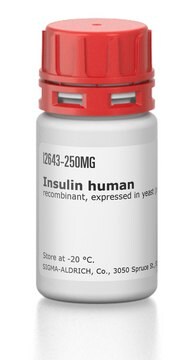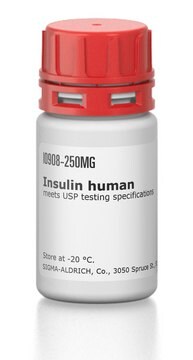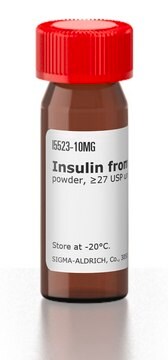I3536
Insulina
recombinant, expressed in yeast, γ-irradiated, suitable for cell culture
Sinonimo/i:
Insulin human
About This Item
Prodotti consigliati
Ricombinante
expressed in yeast
Livello qualitativo
Sterilità
γ-irradiated
Forma fisica
lyophilized powder
Potenza
≥25 USP units per mg
tecniche
cell culture | mammalian: suitable
Solubilità
0.01 M HCl: 20 mg/mL, clear, colorless to faintly yellow
N° accesso UniProt
Condizioni di spedizione
ambient
Temperatura di conservazione
−20°C
InChI
PBGKTOXHQIOBKM-FHFVDXKLSA-N
Informazioni sul gene
human ... INS(3630)
Cerchi prodotti simili? Visita Guida al confronto tra prodotti
Categorie correlate
Descrizione generale
Applicazioni
- For adipogenic differentiation assays (in the preparation of medium supplement)
- Incubation of cells for the evaluation of the effects of insulin
- Mass spectrometry (used for the external caliberation)
Azioni biochim/fisiol
Altre note
Codice della classe di stoccaggio
13 - Non Combustible Solids
Classe di pericolosità dell'acqua (WGK)
WGK 2
Punto d’infiammabilità (°C)
Not applicable
Certificati d'analisi (COA)
Cerca il Certificati d'analisi (COA) digitando il numero di lotto/batch corrispondente. I numeri di lotto o di batch sono stampati sull'etichetta dei prodotti dopo la parola ‘Lotto’ o ‘Batch’.
Possiedi già questo prodotto?
I documenti relativi ai prodotti acquistati recentemente sono disponibili nell’Archivio dei documenti.
Il team dei nostri ricercatori vanta grande esperienza in tutte le aree della ricerca quali Life Science, scienza dei materiali, sintesi chimica, cromatografia, discipline analitiche, ecc..
Contatta l'Assistenza Tecnica.




